Diving into Plovdiv, Bulgaria’s second-largest city, is a journey through a beautifully preserved past and a vibrant present. From wandering the cobbled lanes of Plovdiv Old Town to marveling at the Ancient Roman ruins, each step is steeped in history.
The city’s museums offer a deep dive into its rich heritage, making it a top tourist attraction for anyone planning a trip to Bulgaria. Don’t miss the panoramic views from the top of the hill, where the city’s layered stories come alive.
Restaurants in Plovdiv serve up a taste of local cuisine, adding flavor to your exploration. Truly, a visit to Plovdiv is worth the trip, offering the best blend of historical treasures and culinary delights, all within the picturesque setting of this preserved city.
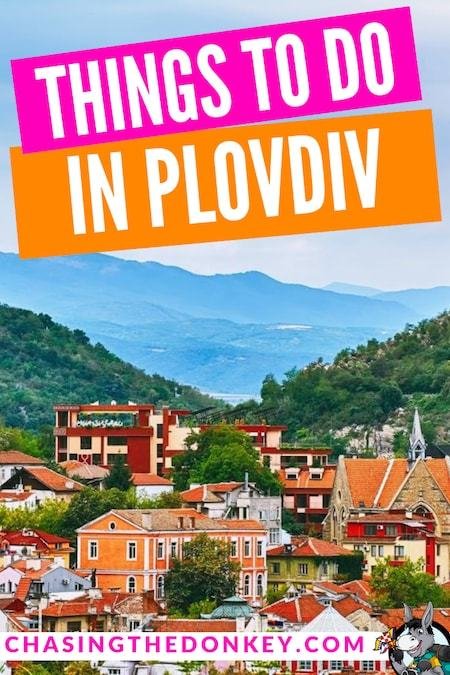
The 2019 European Capital of Culture and Bulgaria’s second-largest city in Bulgaria, Plovdiv, is one of the country’s top tourist destinations and the eastern Balkans.
There are many things to do in Plovdiv, primarily thanks to its incredibly long history and rich cultural heritage.
Spread across seven hills in a fertile region in south-central Bulgaria, the area that now makes up Plovdiv has been inhabited for no less than 8,000 years.
The first Neolithic settlements discovered here date back to 6,000 BC. Since Plovdiv still exists, it’s often regarded as one of the world’s oldest still-inhabited cities. While there’s some debate among scientists about that, it’s unquestionably one of the oldest cities in Europe.
Over the millennia, the city—known in Antiquity as Philippopolis—has been occupied by Thracians, Greeks, Romans, Huns, Bulgars, Slavs, western Crusaders, and The Ottoman Empire, among other peoples.
As such, it now has an exceptional wealth of historic architecture, is a center of arts and crafts, and has its fair share of excellent museums.
Skip Ahead To My Advice Here!
Best Things To Do In Plovdiv – Attractions In Plovdiv

If you’re wondering what to see and do in Plovdiv, you’ll find plenty of options below. This list features all “mandatory” things to do in Plovdiv, the very highlights of this ancient city. You may not be able to visit them all in just one weekend, but I recommend trying your hardest!
Don’t miss the Old Town, Roman Stadium and Amphitheater, the Kapana Art District, and the Regional Ethnographic Museum if you only have one day. I’d focus on those places—the top attractions in Plovdiv. Let’s now dive in and take a look at the best Plovdiv activities in more detail.
Best Historical & Cultural Sites To See In Plovdiv
1. Plovdiv Old Town
Situated on three different hills—Nebet Tepe, Taksim Tepe, and Dzhambaz Tepe—the Old Town of Plovdiv is where you’ll find most historic ruins and architecture well as several superb museums. It’s home to an extraordinary collection of ancient buildings, traditional houses, and cobblestones, combining Antiquity, the Middle Ages, and Bulgarian Revival structures.
This is the beating heart of Plovdiv tourism, one of the most visited places in Bulgaria, and home to many other attractions listed below. Start your visit here. Moreover, if you only have limited time in Plovdiv, this is the same area you should focus on. From restaurants and cafés to various museums and the top Plovdiv attractions, most action occurs in the Old Town.
2. The Medieval Hisar Kapia Gate

The Hisar Kapia Gate is in the Old Town and is one of the top tourist sights in Plovdiv. Built in the 11th century, this wonderfully preserved medieval city gate was one of three entrances to ancient Plovdiv. This current gate was actually constructed on top of the foundation of a previous Roman gate.
During Ottoman rule, Plovdiv’s wealthy merchants built houses over the fortified walls on both sides of the Hisar Kapia Gate. Nowadays, the ground floors of these houses still have the original medieval walls.
3. Nebet Tepe
One of the first Plovdiv Hills to be inhabited by people, Nebet Tepe is home to settlements dating back to 4,000 BC. First, the home of the Thracians. In the Thracian times the village grew in size under Philip II of Macedon and Ancient Rome.
Eventually, it became the citadel of the Old Town. Now a beautiful hill filled with ruins, it’s one of the best places to visit in Plovdiv for an insight into the history of ancient Philippopolis.
An expansive archaeological complex lies atop Nebet Tepe, including the ruins of fortified walls and towers. It’s a monument of national importance in Bulgaria and one of the most popular sights in Plovdiv.
4. The Eastern Gate Of Philippopolis
One of only three discovered entrances to the ancient city of Philippopolis; the Eastern Gate was on the main road from the city to Byzantium (later Constantinople and modern-day Istanbul).
The first gate built on this site dates from the 2nd century and the reign of Hadrian. In the 4th and 5th centuries, restoration and reparation of this gated complex took place. It’s thought it was the largest and most important entrance to ancient Philippopolis.
All that remains now is a collection of ruins and the general layout of the gate complex. It’s one of many Ancient Roman attractions in Plovdiv.
5. The Roman Stadium
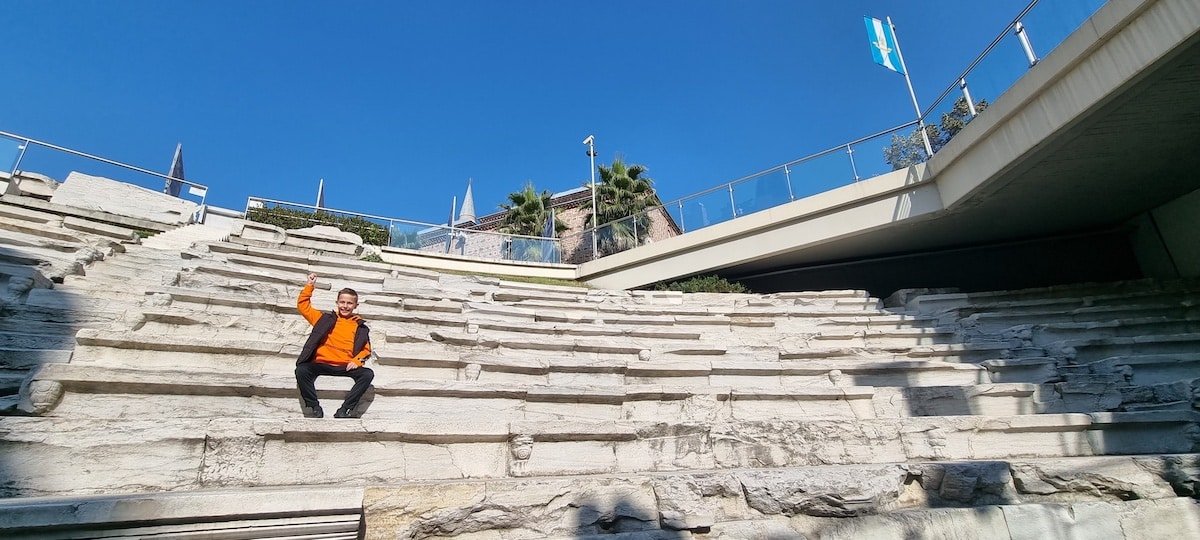
One of the largest and best-preserved Ancient Roman structures in the Balkans, the Plovdiv Roman Stadium is one of the top attractions in Plovdiv. Constructed in the early 2nd century by Emperor Hadrian, it could seat no fewer than 30,000 people. Fifty meters wide and 240 meters long, it was the setting of huge sporting events. Art, music, and poetry contests are also used to accompany these events.
Nowadays, you can see the marvelously renovated portion of the northern part of the Roman Stadium. It’s one of the prominent landmarks in Plovdiv that you can’t miss – you can even see a part of it in the H&M store.
Kids will love the 3D cinema of the Roman stadium, for which you can buy tickets from between 3-6 LEV each. Screen times for the 3D movie are 10:00,10:40, 11:20, 12:00, 13:40, 14:20, 15:00, 15:40, 16:20, and 17:00. My boys enjoyed the short video, although I wouldn’t suggest you wait around to long watch it as we did, it was not worth the 30 minutes wait.
Brands We Use And Trust
Best Tours To Explore Plovdiv City
6. Plovdiv Walking Tour
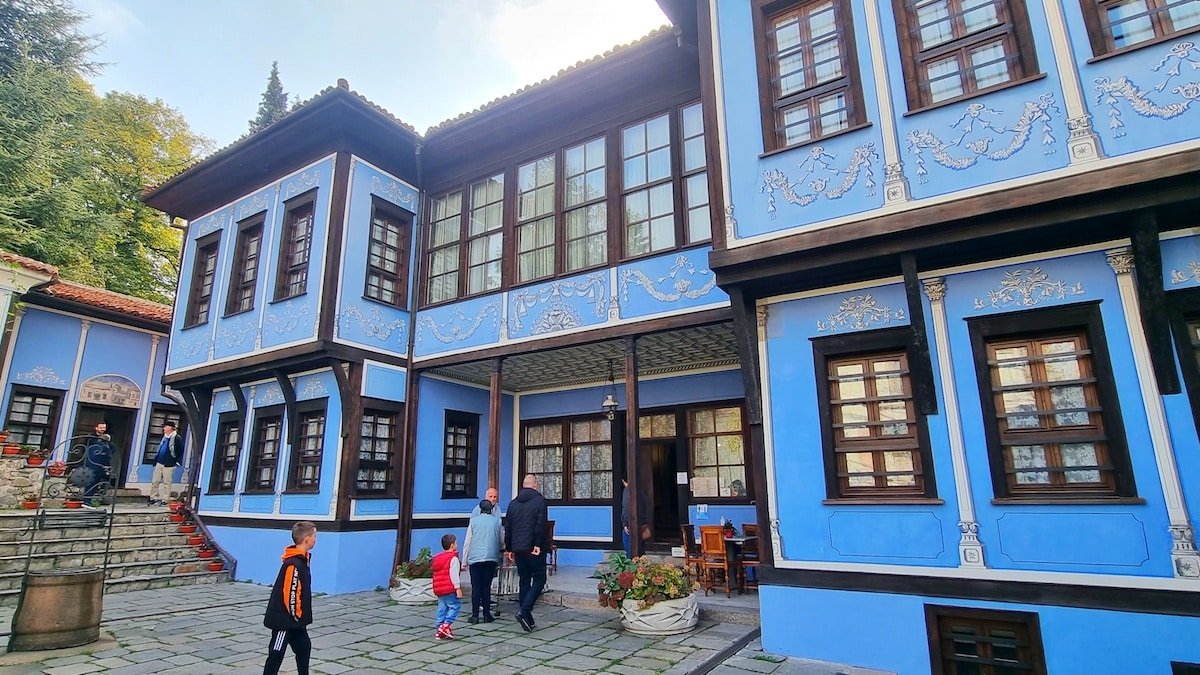
If you enjoy seeing the sites with a local guide, this walking tour in Plovdiv is a great way to experience the highlights of Plovdiv.
You will tour Plovdiv’s central area, with the most significant landmarks, including Park Tsar Simeon, Stadium of Philippopolis, Plovdiv Old Town, Plovdiv Roman Theatre, St. Constantine and Helena Church, Hisar Kapia, Ethnographic Museum, Nebet Tepe, Balabanov House, House-Museum Hindliyan and the Kapana District.
7. 3-D Virtual Tour Of The Ancient Stadium Of Philippopolis
Get ready to travel back in time to experience this amazing piece of history!
Have you ever wondered how a historical structure looked in its prime, but had trouble visualizing it? This 3-D virtual tour of the Ancient Stadium of Philippopolis is a super cool way to see the hypothesis of how historians and archaeologists believe the building looked at the time of construction (beginning of the 2nd century AD).
Theaters, Heritage Mosaics & Street Art Around Plovdiv
8. Plovdiv Roman Theatre – Ancient Theatre of Philippopolis
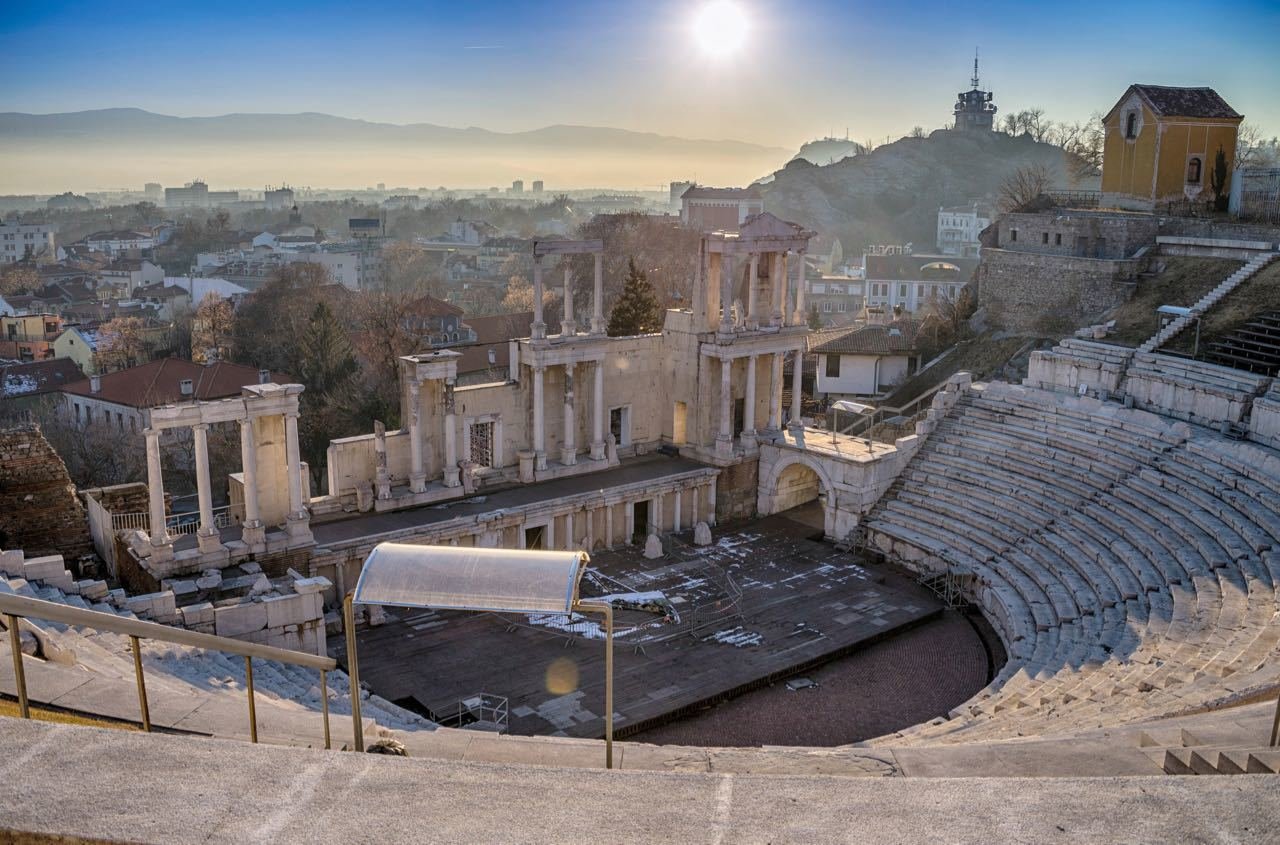
If you’re a fan of Ancient Roman architecture, you must visit the Ancient Ancient Amphitheater Philippopolis.
It lies in the heart of the Old Town, in the saddle between Taksim Tepe and Dzhambaz Tepe. Dating from Trajan’s reign in the late 1st century and early 2nd century, it’s one of the world’s best-preserved ancient theaters.
Historians presume that this theater used to hold performances, theatre performances, gladiator games, and hunting spectacles circus events. Damaged in the 5th century by Attila the Hun, it got buried and was eventually forgotten. It wasn’t until the mid-20th century that it was rediscovered thanks to a landslide. Its restoration is an absolute masterpiece, and the theater is now used once again as a concert and theater venue (in summer). It can seat 5,000 to 7,000 people.
9. Mosaics From The Episcopal (Bishop’s) Basilica Of Philippopolis
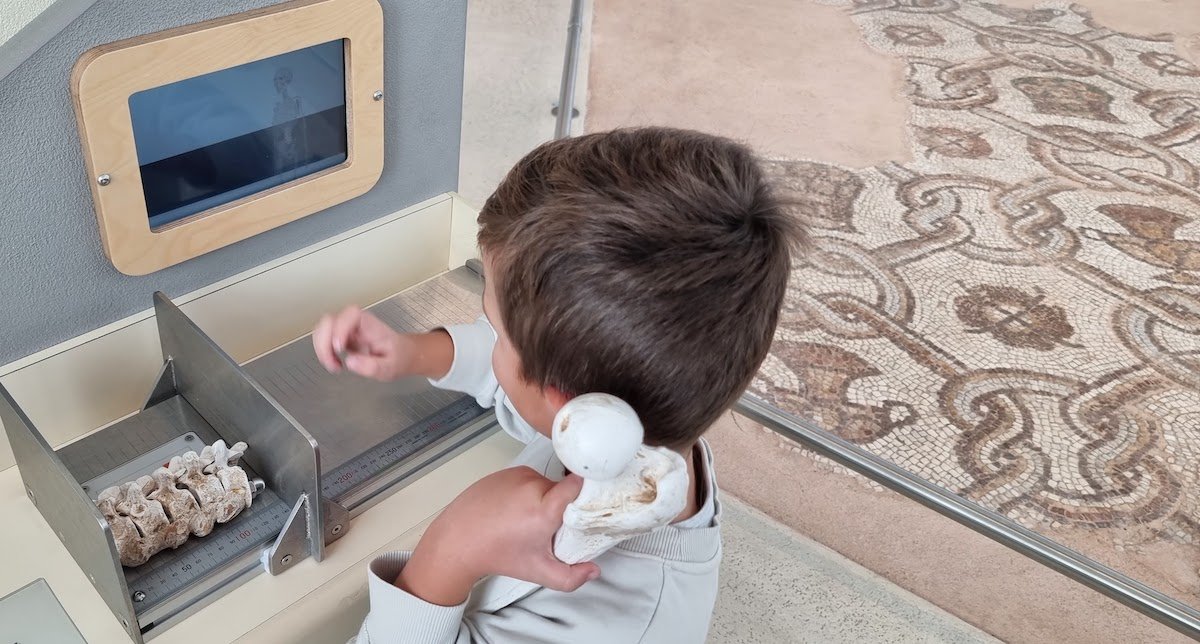
Also known as the Great Basilica, the Episcopal Basilica of Philippopolis was discovered and excavated by archaeologist Elena Kessiakova in the 1980’s. As the project progressed over the years, it was discovered that the complex’s interior was covered in mosaics, especially the floors.
A modernized building was constructed to cover and protect the original basilica and the mosaics were stabilized, cleaned and preserved within. Today, guests can visit the building to view areas of excavated mosaic in different styles and learn about the building’s history.
10. Mosaic “Postal Pigeons”
The “Postal Pigeons” mosaic can be found in the Central Post Office along most of the foyer’s northern wall.
Designed by artist Georgi Bozhilov – Slona in 1977, this three dimensional scene of stylized pigeons was made using used natural stone tesserae in five colors – black, white (marble and white limestone), ochre, light green, and dark green. The artist was quite skilled in mosaic technique, and designed “Postal Pigeons” in such a way that it was installed in just one day.
11. 3D Mosaic In A Water Facility
This impressive mosaic can be found in front of the Polyclinic of the Trakiya Neighborhood.
Decorative stone tesserae in four colors: white (marble), black-gray, ochre (limestone) and red (smalt), cover globular sculptures in this unique 3-D mosaic display. Despite the curvature of the sculptures, the stones were laid so carefully that the mosaic creates an even surface to the structure.
12. The Kapana Art District
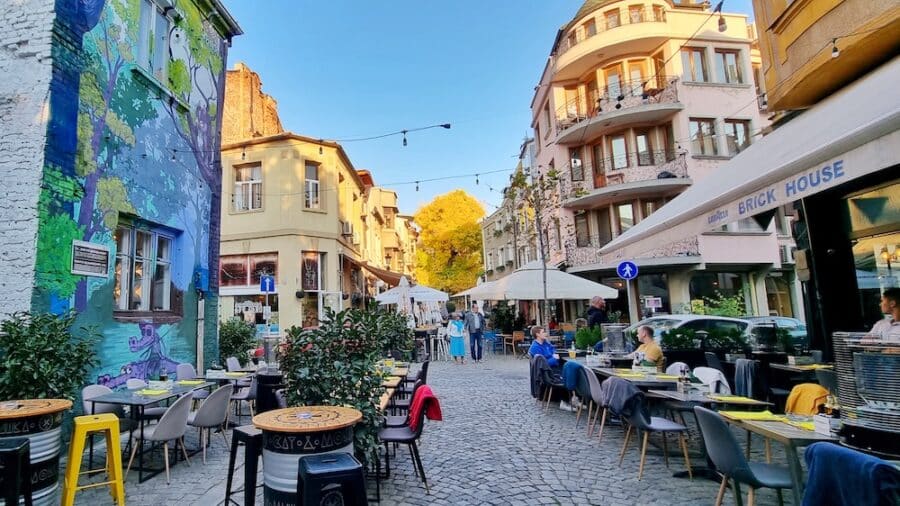
For a break from all that history and archaeology, head to the Kapana Art District, the liveliest neighborhood in Plovdiv. Until quite recently, a neglected and overlooked part of the city, it’s its cultural heart.
The district is more than 500 years old, dating from when it was home to numerous craftsmen, such as cloth makers, tailors, blacksmiths, goldsmiths, and leather workers.
If you understand Bulgarian, you’ll notice many streets bearing the names of those crafts—translated as, for example, Iron Street and Gold Street. The district’s name literally means “The Trap” after its dense network of little streets and alleys.
In the 2010s, the Kapana Art District underwent extensive restorations. Many old buildings were renovated, empty storefronts became art galleries, and the entire area was made car-free. Nowadays, Kapana is home to countless art shops, galleries, wine bars, restaurants, and beer halls. It’s the perfect place to hang out on a sunny afternoon or after a well-filled day of sightseeing in Plovdiv.
Best Shopping, Parks & Leisure In Plovdiv
13. The Pedestrian Street Of Knyaz Alexander I
Also known as Main Street, Knyaz Alexander I Street is the longest pedestrian street in Europe at 1750 m in length. It connects the Kapana Art District with Old Town Plovdiv and is the main shopping street in the city.
Along this bustling and lively street you will find shopping boutiques, international chains, cafes and restaurants, and the historical Dzhumaya Mosque and Roman Stadium.
14. Park Tsar Simeon
Visiting this ancient garden is a great way to relax in Plovdiv. Cascading trees shade the pathways and delightful garden beds show off all varieties of flowers.
Swiss landscape architect Lucien Chevalas designed this public park in 1892. It’s a lush and peaceful area within easy walking distance from the central Old Town. If you walk along Main Street, you will find Park Tsar Simeon at the end, before you reach the Kapana Art District.
Highlights include the Goddess Demeter Fountain, a Viennese Pavilion, modern children’s playgrounds, flowerbeds, and the star of the show, the Singing Fountains (more on those below).
15. Singing Fountains At Night

One of the most remarkable and fun things to do in Plovdiv is watching the Singing Fountains in Tsar Simeon’s Garden.
Located in a lake in the park, this collection of fountains is the setting of a light and music show that takes place every Friday, Saturday, and Sunday at 9 p.m.
16. Sunset Views From Dzendem Tepe
Situated in the western part of Plovdiv, Dzendem Tepe is the highest of the city’s seven hills. Having been home to a Bronze Age shrine (or even a small settlement), an important Roman Temple of Apollo, and a 4th-century basilica, the hill is now a natural landmark.
Towering over much of the rest of Plovdiv, its summit is a phenomenal spot to watch the sunset.
Best Churches & Mosques In Plovdiv

17. Visit The Church Of St. Constantine And Helena
Another fascinating historic building in the Plovdiv Old Town is the Church of St. Constantine and Helena. Named after Emperor Constantine the Great and his mother, Helena, it’s one of the oldest churches in Plovdiv. It dates from the year 337.
Over the following centuries, it was destroyed and reconstructed multiple times. The present structure dates from 1832 and has gorgeous frescoes, icons, and paintings.
18. See The Church Of The Holy Mother Of God
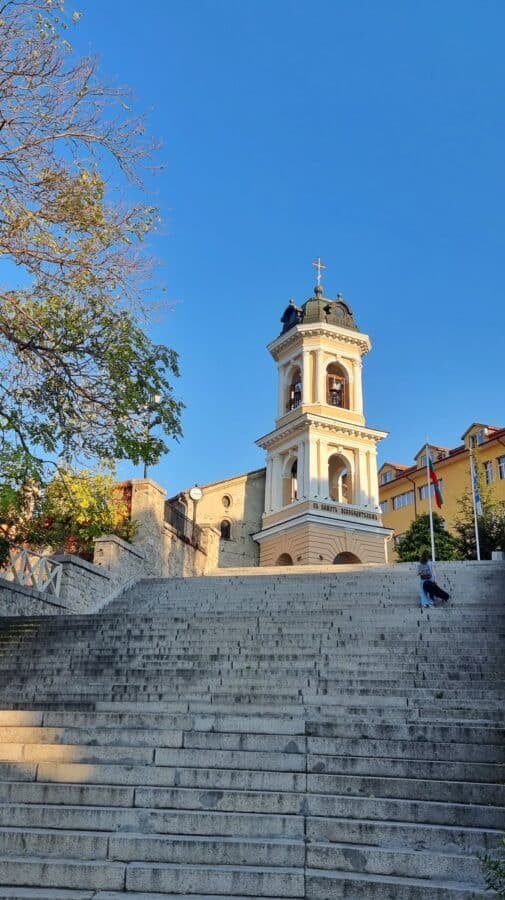
The Church of the Holy Mother of God is one of the most important churches in Plovdiv. A church has stood on this site since the 9th century but was destroyed by the Ottomans when they conquered Plovdiv in the late 14th century.
The current building dates from 1844 when it was rebuilt as the main church in the city. This church and one of its bishops played a significant role in the Bulgarian Orthodox Church’s struggle for autonomy. It has a strikingly beautiful tower as well as icons and frescoes.
19. Admire The Dzhumaya Mosque

The presence of the gorgeous Dzhumaya Mosque is a testimony to the cultural diversity that so characterizes the eastern Balkans. Plovdiv’s main Muslim building, it stands in the city center west of the Old Town. The Ottomans built the original mosque in the 14th century on the previous St. Petka Tarnovska Cathedral Church site. In the 15th century, however, that first mosque was taken down and replaced by the current building.
Among its many features are nine large domes and a towering minaret — Wall paintings inside date from the late 1700s and early-1800’s.
Best Museums In Plovdiv
As one of Europe’s oldest cities, Plovdiv has a massive amount of history and cultural heritage. After reading about the things to see in Plovdiv above, you’ll now know all about that, too. However, if you’d like to learn even more about the city’s millennia-long history, I recommend visiting the following Plovdiv museums.
20. Regional Ethnographic Museum Plovdiv

Housed in the former residence of 19th-century merchant Argir Kuyumdzhioglu in the Old Town, the Regional Ethnographic Museum is one of the best museums in Plovdiv. It has six different exhibits, all located in separate rooms in the house.
Those exhibits house several thousands of artifacts and objects. They range from furniture, clothing, and fabrics to religious items, music instruments, books, and artworks.
21. Balabanov House
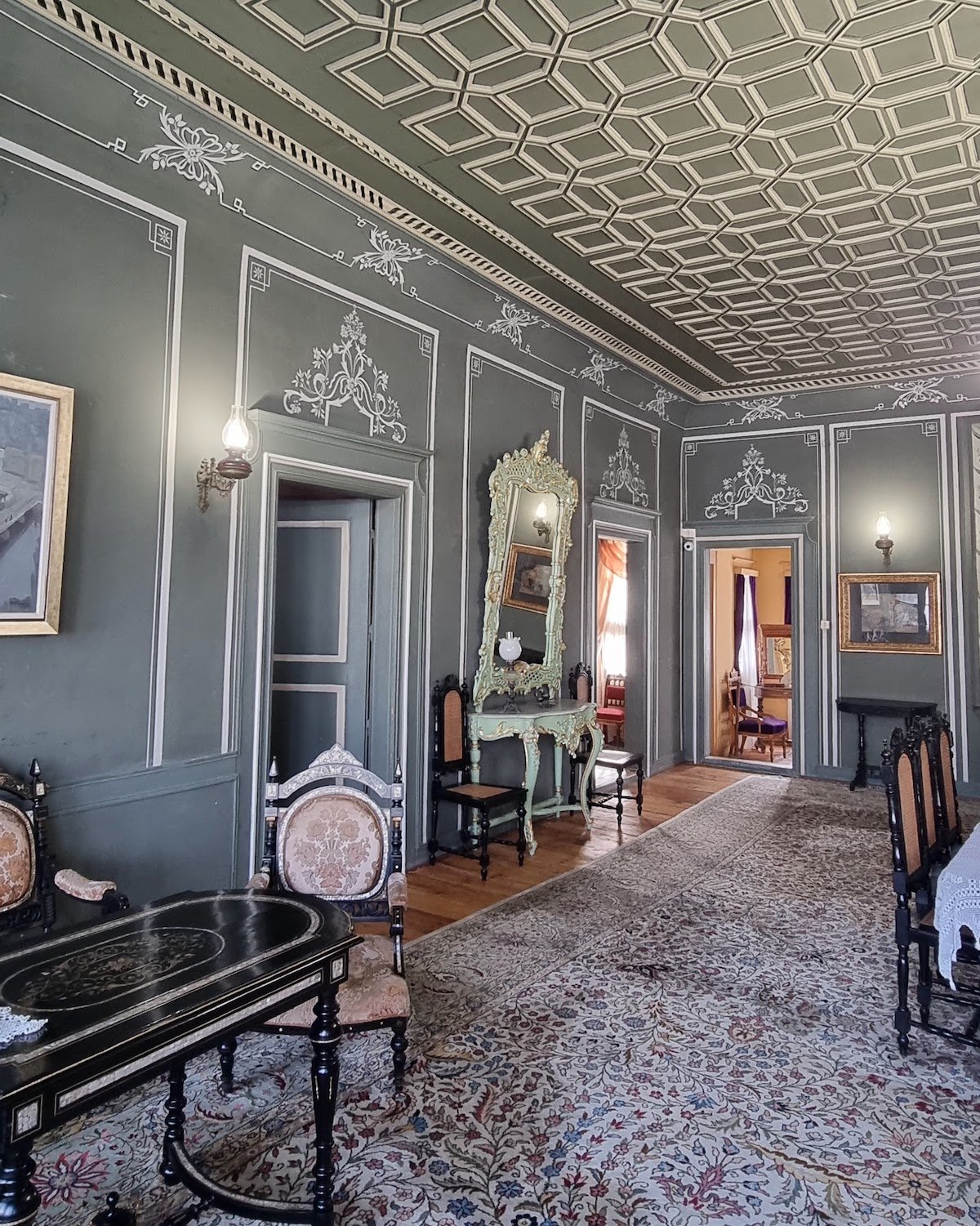
Much like the Regional Ethnographic Museum, Balabanov’s House also houses various cultural and historical objects. This 19th-century house near St. Constantine and Helena Square boasts a beautiful exterior. Inside, you’ll find antique furniture, carved-wood ceilings, clothes, and other items showcasing how affluent Plovdiv residents used to live in the 1800s.
Similar preserved homes of influential Plovdiv residents in the city include Hindlyan’s House and Lamartine/Mavridi’s House.
22. Klianti House
You will find Klianti House in the Ancient Plovdiv architectural and historic reserve. Buildings in this neighborhood were built during the National Bulgarian Revival period and possess elements of cultural, artistic and decorative importance.
Klianti House, also called the “people’s monument of culture”, is the oldest Revival house, known for its mural paintings, monochrome ceilings, enclosed wooden recesses, unique architecture and asymmetrical design.
23. House Of Nikola Nedkovich
While in the historic reserve, also stop at the house of Nikola Nedkovich, a prosperous fabric merchant who had the home built in 1863.
The home is a wonderful example of the classic symmetrical Plovdiv house, and many preserved artifacts from the original owners are on display.
Ornate murals, carved ceilings, period furniture, an underground tunnel connecting the cellar with the street and a covered passage from the kitchen into the main building are a few of the exuberant features guests can admire when touring this home.
24. Plovdiv National Archaeological Museum
Officially opened in 1882, this is one of the oldest museums in Bulgaria. The National Archaeological Museum in Plovdiv now houses one of the largest and most important cultural heritage collections related to Plovdiv and the surrounding region. It has no fewer than 100,000 items and objects.
This fantastic history museum focuses on the early history of Plovdiv, from prehistoric times through the Middle Ages, including the Thracian, Roman, and early-Christian times. You’ll find numerous fascinating artifacts here, from ancient pottery and sculptures to Christian iconography and medieval art.
25. Plovdiv Regional Historical Museum
While the National Archaeological Museum covers Plovdiv’s ancient history, the Regional Historical Museum focuses on the 15th century through today. Established in 1951, this cultural and research organization preserves and studies Plovdiv’s more recent history.
The museum has four different exhibits located in various locations in the city:
- The Unification of Bulgaria of 1885 – dedicated to the role Plovdiv played in the late 19th century events, from the Treaty of Berlin that resulted in the division of Bulgaria into five regions to the 1885 Serbo-Bulgarian War.
- Bulgarian National Revival – housed in the former residence of mid-19th-century Greek merchant Dimitris Georgiadi, this exhibit covers the period of Ottoman rule in Plovdiv, from the 15th to the 19th
- Museum Center of Modern History – hosts seminars, presentations, other public happenings, and art and photography exhibits.
- Book Publishing in Bulgaria – occupying six rooms in the house of Hristo G. Danov, a famous early-19th-century publisher, this exhibit traces the evolution of publishing in Plovdiv through the late-1800’s and early-1900’s.
26. Museum of Natural Sciences
Located in the old 1880 Plovdiv Municipality building, the Museum of Natural Sciences is one of the best things to do in Plovdiv for nature lovers. It’s one of the most important museums of its kind in Bulgaria, featuring impressive collections in the scientific realms of paleontology, botany, and mineralogy.
Several rooms are dedicated to wildlife, too. Arguably its main attraction is the enormous freshwater aquarium home to 40 different species. It’s Bulgaria’s largest freshwater aquarium.
Best Bulgarian Places To Eat In Plovdiv (Or Drink!)
There are no shortage of places to eat in Plovdiv – and maybe just as many more choices of places to drink a coffee or sip a glass of Bulgarian wine.
Here are some of the places we loved:
Divino Cafe
We stopped here to get our bearings on where we should eat; we sat and enjoyed a few glasses of Bulgarian wine and people-watched.
Address ul. “Hristo Dyukmedzhiev” 3, 4000 Kapana, Plovdiv
Pavaj Restauarant
Dine on tasty, authentic cuisine right in the heart of Plovdiv as this casual restaurant, with offerings that also include vegan, vegetarian and gluten free options. Bring cash as cards aren’t accepted here (at least at the time of writing this).
Address Zlatarska No 7 Kapana District, Plovdiv 4000
Aylyakria
This contemporary gastropub is set in a 100 year old building, providing a cozy atmosphere for your dining experience. Craft beers, cocktails and a delicious house wine are all worth an order and the seasonal rotating menu is carefully selected to bring guests traditional Bulgarian dishes with a twist along with popular dishes from around the world made with local ingredients.
Address Kozhuharska 3, Plovdiv 4000
Mayriges
If you’re in the mood for something different, head to Mayriges (“My Mother”) where you can eat traditional Armenian and Lebanese dishes, home-cooked using childhood recipes passed down by the chef’s mother.
There is a children’s menu available if you are traveling with pickier eaters.
Address “Konstantin Stoilov” 14, Plovdiv
Turkish Coffee and Pastry Shop “Dzhumaya”
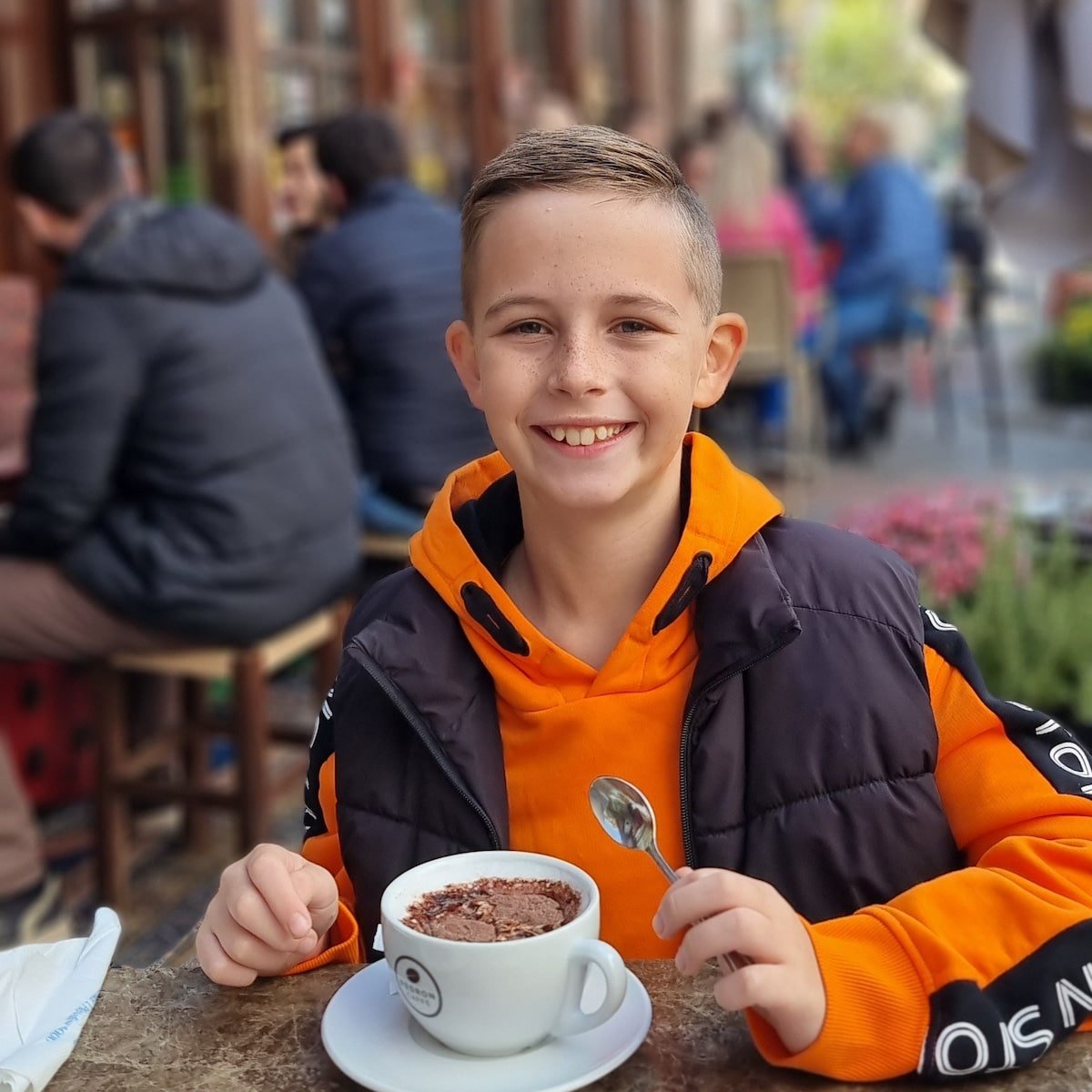
For something sweet, head to Dzhumaya for traditional Turkish desserts and drinks.
Address ul. “Zhelezarska” 1, 4000 Plovdiv
Cafes Near “The Pelican Fountain”
The Pelican Fountain is found in front of the Plovdiv Municipality, near the Garden of Tsar Simeon. This fountain is a popular spot for young people to hang out and for children to run around while parents enjoy sipping on coffee or cocktails at any of the nearby cafes. It can be especially fun in the evening when the fountain waters light up.
Address Stefan Stambolov Square,Plovdiv
Central Perk
If you are a fan of the television show “Friends”, this cafe is a must. The place is styled after the popular Friends hang out spot. The atmosphere is young and bubbly, and it’s a great place to stop for a drink while out in Kapana.
Address ul. “Hristo Dyukmedzhiev” 16, 4000 Kapana, Plovdiv
Move This Adventure To Your Inbox & Get An Instant Freebie

No spam. Unsubscribe at any time.
Best Places For Day Trips From Plovdiv, Bulgaria
27. Visit Bachkovo Monastery

A 30-minute drive from Plovdiv brings you to the Bachkovo Monastery, a major Eastern Orthodox monastery on the bank of the Chepelare River. Founded in 1033, it was a large complex with many buildings. Currently, only one part survives from those earliest days. That’s the ossuary with its ancient frescoes and typical architectural style that doesn’t exist anywhere else in the world.
The monastery does include various other buildings, though, all constructed in subsequent centuries. Note-worthy highlights are the 17th-century Cathedral Church of the Virgin Mary, the “Panorama” Mural, and the medieval Church of the Archangels.
28. Go For A Trip To Asen’s Fortress
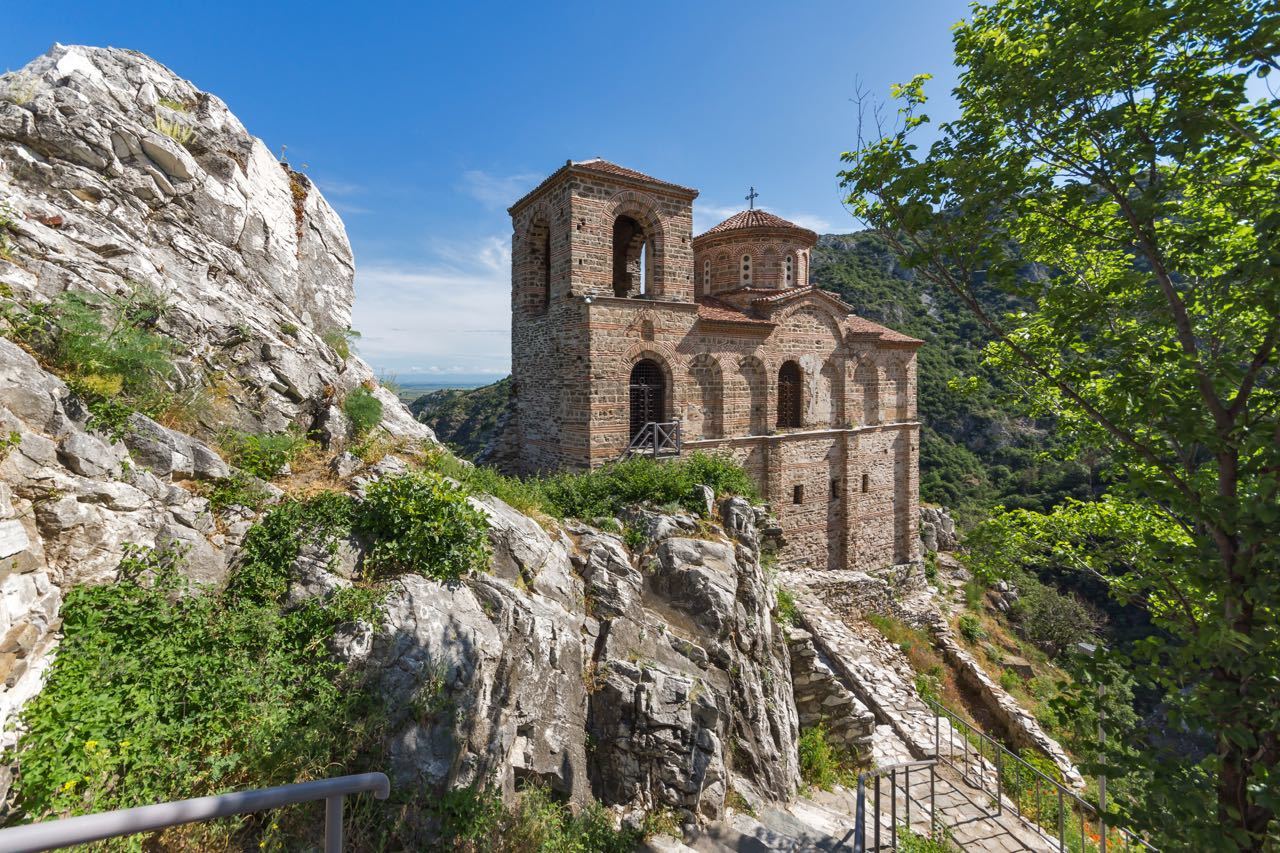
Asen’s fortress lies on the way to the Bachkovo Monastery in Asenovgrad. This imposing medieval stronghold is one of the top castles in Bulgaria to visit. Perched atop a rocky outcrop, it is only accessible from one side. The three other sides have nearly vertical drops in the valley below.
Dating from the Middle Ages, Asen’s Fortress went through several sieges, including the conquest by the armies of the Third Crusade and, later, the Ottomans.
After the 14th-century Ottoman conquest, the castle was left to decay. Now, only one complete building still stands. The 11th– and 12th-century Church of the Holy Mother of God is still in use as a Bulgarian Orthodox church. The rest of this once-mighty fortress are ruins, although exceptionally well-preserved ruins.
29. Have Some Water Fun At Aqualand
While all other things to do in Plovdiv described above have something, or everything, to do with culture and history, this last one is just plainly about having fun. Aquapark “Aqualand” is arguably the most well-known modern attraction in the city.
This large water park is a great place to take your kids if they’re tired of walking around and sightseeing in Plovdiv. It features lounge areas, a children’s pool, tubing, and thrill slides.
The only question now is, where will you start in Plovdiv? And, if you have another suggestion for what to see in Plovdiv, leave us a comment below.

